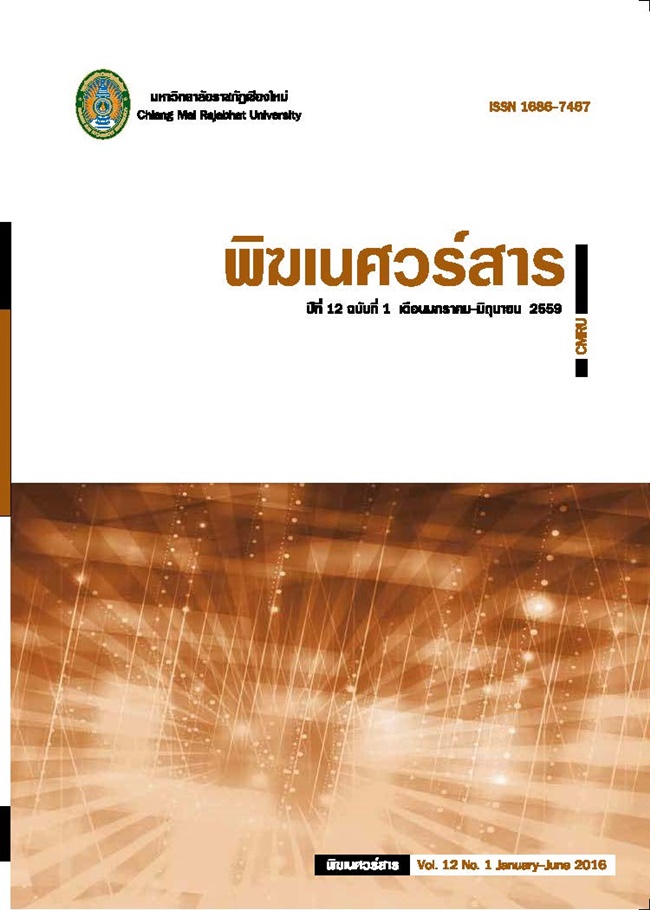การศึกษาความสัมพันธ์ระหว่างบรรยากาศในโรงเรียนและบรรยากาศในครอบครัว กับผลสัมฤทธิ์ทางการเรียนของนักเรียนระดับชั้นมัธยมศึกษาปีที่ 3 ในโรงเรียนสังกัดกรุงเทพมหานคร
Main Article Content
Abstract
การวิจัยครั้งนี้มีวัตถุประสงค์ (1) เพื่อศึกษาลักษณะบรรยากาศในโรงเรียน บรรยากาศในครอบครัว และผลสัมฤทธิ์ทางการเรียนของนักเรียน (2) เพื่อศึกษาความสัมพันธ์ระหว่างบรรยากาศในโรงเรียนและบรรยากาศในครอบครัวกับผลสัมฤทธิ์ทางการเรียนของนักเรียนกลุ่มตัวอย่างที่ใช้ในการวิจัยเป็นเป็นนักเรียนที่กำลังศึกษาอยู่ในระดับชั้นมัธยมศึกษาปีที่ 3 ในโรงเรียนสังกัดกรุงเทพมหานคร ภาคเรียนที่ 2 ปีการศึกษา 2557 จำนวน 419 คน ได้มาโดยวิธีการสุ่มแบบหลายขั้นตอน (multi - Stage Sampling) เครื่องมือที่ใช้เก็บรวบรวมข้อมูลได้แก่ แบบสอบถาม สถิติที่ใช้ในบรรยายข้อมูลประกอบด้วยค่าเฉลี่ย ร้อยละ ส่วนเบี่ยงเบนมาตรฐาน และสถิติที่ใช้ทดสอบความสัมพันธ์ระหว่างตัวแปรอิสระและตัวแปรตาม ได้แก่ สัมประสิทธิ์สหสัมพันธ์แบบเพียร์สัน (Pearson’ product moment correlation coefficient) และการวิเคราะห์ถดถอยพหุ (multiple regression analysis) จากการศึกษาความสัมพันธ์ระหว่างบรรยากาศในโรงเรียน บรรยากาศในครอบครัว และผลสัมฤทธิ์ทางการเรียน พบว่า บรรยากาศในโรงเรียนด้านกายภาพของนักเรียน มีค่าเฉลี่ยเท่ากับ 64.58 คิดเป็นร้อยละ 72 มีค่าส่วนเบี่ยงเบนมาตรฐาน 9.270 โดยมีคะแนนสูงสุด 85 คะแนน และคะแนนต่ำสุด 17 คะแนน บรรยากาศในโรงเรียนด้านวิชาการ มีค่าเฉลี่ยเท่ากับ 20.83 คิดเป็นร้อยละ 26 มีค่าส่วนเบี่ยงเบนมาตรฐาน 10.482 โดยมีคะแนนสูงสุด 76 คะแนน และคะแนนต่ำสุด 0 คะแนน บรรยากาศในครอบครัวแบบรักสนับสนุน มีค่าเฉลี่ยเท่ากับ 6.32 คิดเป็นร้อยละ 30 มีค่าส่วนเบี่ยงเบนมาตรฐาน 4.037 โดยมีคะแนนสูงสุด 14คะแนน และคะแนนต่ำสุด 0 คะแนน บรรยากาศในครอบครัวแบบใช้เหตุผล มีค่าเฉลี่ยเท่ากับ 3.79 คิดเป็นร้อยละ 25 มีค่าส่วนเบี่ยงเบนมาตรฐาน 2.819 โดยมีคะแนนสูงสุด 15 คะแนน และคะแนนต่ำสุด0 คะแนน และบรรยากาศในครอบครัวแบบควบคุม มีค่าเฉลี่ยเท่ากับ 3.14 คิดเป็นร้อยละ 26 มีค่าส่วนเบี่ยงเบนมาตรฐาน 2.462 โดยมีคะแนนสูงสุด 8 คะแนน และคะแนนต่ำสุด 0 คะแนน ส่วนผลสัมฤทธิ์ทางการเรียนของนักเรียน มีค่าเฉลี่ยเท่ากับ 2.90 คิดเป็นร้อยละ 72 มีค่าส่วนเบี่ยงเบนมาตรฐาน .637 โดยมีผลสัมฤทธิ์ทางการเรียนสูงสุด 4.00 และต่ำสุด เท่ากับ 1.05 ตัวแปรที่มีความสัมพันธ์อย่างมีนัยสำคัญทางสถิติที่ระดับ .01 ได้แก่ บรรยากาศในครอบครัวแบบควบคุม (X5) บรรยากาศในครอบครัวแบบใช้เหตุผล (X4) บรรยากาศในครอบครัวแบบรักสนับสนุน (X3) และบรรยากาศในโรงเรียนด้านวิชาการ(X2) ส่วนบรรยากาศในโรงเรียนด้านกายภาพ (X1) ไม่พบนัยสำคัญทางสถิติ สัมประสิทธิ์สหสัมพันธ์ระหว่างชุดตัวแปรอิสระกับตัวแปรตามเท่ากับ .236 โดยชุดตัวแปรอิสระสามารถอธิบายความแปรปรวนในตัวแปรตามได้ร้อยละ 4.4 และสัมประสิทธิ์ถดถอยของตัวแปรที่พบนัยสำคัญทางสถิติที่ระดับ .05 คือ บรรยากาศในครอบครัวแบบรักสนับสนุนและบรรยากาศในครอบครัวแบบควบคุม โดยบรรยากาศในครอบครัวแบบรักสนับสนุนมีอิทธิพลต่อตัวแปรตาม (β =.242) มากกว่าบรรยากาศในโรงเรียนด้านวิชาการ (β = .083)
A Study of the Relationships Between School Atmosphere and Family Atmosphere and the Academic Achievement of Matthayom Sueksa Three Students in Schools Under the Jurisdiction of the Bangkok Metropolitan Administration
In this thesis, the researcher studies (1) the school atmosphere and family atmosphere and the academic achievement of the students under study. The researcher also examines (2) the relationships between the school atmosphere and family atmosphere and the academic achievement of the students under investigation. Using the method of multi - Stage Sampling, the researcher selected a sample population consisting of 419 Matthayom Sueksa three students enrolled in the second semester of the academic year 2014 in schools under the jurisdiction of the Bangkok Metropolitan Administration (BMA). Using techniques of descriptive statistics, the researcher analyzed the data collected in terms of mean, percentage, and standard deviation. In testing the relationships between independent and dependent variables, the researcher employed Pearson’s product moment correlation coefficient method and multiple regression analysis.
Findings are as follows:
The school physical atmosphere of the students showed a mean of 64.58 (72 percent) and a standard deviation of 9.270 with the maximum score at 85 and the lowest score at 17. The school academic atmosphere displayed a mean of 20.83 (26 percent) and a standard deviation of 10.482 with the maximum score at 76 and the lowest score at 0. A supportive family atmosphere exhibited a mean of 6.32 (30 percent) and a standard deviation of 4.037 with the maximum score at 14 and the lowest score at 0. The cooperative family atmosphere showed a mean of 3.79 (25 percent) and a standard deviation of 2.819 with the maximum score at 15 and the lowest score at 0. The authoritarian family atmosphere displayed a mean of 3.14 (26 percent) and a standard deviation of 2.462 with the maximum score at 8 and the lowest score at 0. The students’ academic achievement displayed a mean of 2.90 (72 percent) and a standard deviation of .637. The highest score for academic achievement was 4.00 and the lowest score was 1.05.
Four variables were correlated with academic achievement at the statistically significant level of .01. The variables exhibiting the highest level of relationship were the authoritarian family atmosphere (X5) cooperative family atmosphere (X4), supportive family atmosphere (X3) and school academic atmosphere (X2). The correlation coefficients were .387, .256, .252, and .156, respectively. No statistically significant level was found in regard to school physical atmosphere (X1). The correlation coefficient for the relationship between the independent and dependent variables was .236. The independent variables were explanatory of variance in the dependent variables at 4.4 percent. Testing yielded statistical significance at the level of .05. The regression coefficients of variables showing a statistically significant level of .05 were a supportive family atmosphere and an authoritarian family atmosphere. A supportive family atmosphere influenced the dependent variables (β=.242) at a higher level than school academic atmosphere (β=.083).
Downloads
Article Details
The articles published are copyrighted by the Graduate School, Chiang Mai Rajabhat University.
The opinions expressed in each article of this academic journal are solely those of the individual authors and do not reflect the views of Chiang Mai Rajabhat University or its faculty members. The responsibility for the content of each article rests entirely with the respective authors. In the event of any errors, the authors alone are responsible for their own articles.


